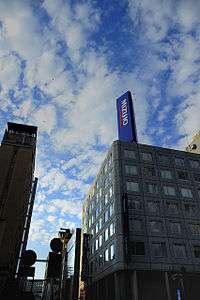Mizuho Bank
 | |
| public company KK (a Mizuho Financial Group company) | |
| Industry | Financial Services |
| Founded | 1897 |
| Headquarters | Otemachi, Chiyoda-ku, Tokyo, Japan |
Key people |
Nobuhide Hayashi (President & CEO) |
| Revenue |
|
|
| |
Number of employees | 26,839 (non-consolidated, July 2014) |
| Parent | Mizuho Financial Group |
| Subsidiaries |
Mizuho Securities UC Card Mizuho Capital Eurekahedge |
| Slogan | One Mizuho |
| Website | www.mizuhobank.com |
.jpg)
Mizuho Bank, Ltd. (株式会社みずほ銀行 Kabushiki-gaisha Mizuho Ginkō) is the integrated retail and corporate banking unit of Mizuho Financial Group (TYO:8411; NYSE:MFG), one of the largest financial services companies in Japan, with total assets of approximately $1.64 trillion in 2014. Mizuho is one of the three so-called Japanese "megabanks" (along with Mitsubishi UFJ Financial Group and Sumitomo Mitsui Financial Group). Mizuho Bank provides financial products and services to a wide range of clients, including individuals, small and medium-sized enterprises, large corporations, financial institutions and public sector entities. Its headquarters office building is located in the Otemachi district of Chiyoda, Tokyo.
Mizuho Bank has over 505 branches and offices in Japan and in thirty-six other countries and regions, and is the only bank to have branches in every prefecture in Japan.
The name “Mizuho” is an archaic Japanese term meaning “golden ears of rice,” and was used in the classical text Nihon Shoki to describe Japan.
History
Announced in 1999, Mizuho Financial Group was established on April 1, 2002 by the merger of Dai-Ichi Kangyo Bank, Fuji Bank and the Industrial Bank of Japan. All three predecessors were major financial institutions in their own right and had served as cornerstones of major zaibatsu (prewar era) and keiretsu (postwar era). In April 2002, Mizuho Corporate Bank and Mizuho Bank were established as two core banking subsidiaries of Mizuho Financial Group through a split and merger process reorganizing the three legacy banks. It was the first financial holding company structure created among major Japanese banks. Mizuho Corporate Bank focused on large corporations, financial institutions and public sector entities in Japan and overseas. Mizuho Bank focused on individuals and small and medium-sized companies in Japan.
Mizuho Corporate Bank engaged in steady expansion overseas, opening twenty overseas offices between 2005 and 2010,[1] particularly in China, as well as in the Americas, Europe and Middle East. In 2006, Mizuho Corporate Bank became the first Japanese bank to obtain financial holding company status in the U.S.,[2] and Mizuho Financial Group listed its ADRs on the New York Stock Exchange.[3]
The two banks were initially consolidated under a holding company, Mizuho Holdings. On October 1, 2005 they were transferred to a new holding vehicle, Mizuho Financial Group. On July 1, 2013, a merger between the former Mizuho Bank and the former Mizuho Corporate Bank took place, and the institution was named Mizuho Bank.[4]
Services
- Current accounts.
- Cash cards for use in Japan only.
- International cash cards.
- International money transfers.
- Credit cards.
- Saving accounts.
- Loans.
- Internet Banking.
- Website.
All services, including Internet Banking and the main website are in Japanese only. Some branches hire English-speaking employees. All services except for international cash cards, credit cards and international money transfers are limited within the territory of Japan.
Restrictions on foreign nationals apply, particularly loans are available only for Japanese nationals and permanent residents of Japan holding permanent employment.
Botched trading scandal of 2005
On Thursday, December 8, 2005, shares of recruitment firm J-com debuted at 610,000 Japanese Yen (¥) ($5,041) on the Tokyo Stock Exchange (the TSE). An inexperienced trader at Mizuho, intending to sell one share at ¥610,000, instead sent an order at 9:27 am to the TSE to sell 610,000 shares of J-com at ¥1 each, essentially attempting to sell $3.075 billion worth of stock for only $5,041. In addition, the size of Mizuho's sell order was 41 times the total number of J-com shares.[5]
See also
References
- ↑ http://www.mizuhobank.com/company/release/cb/index.html
- ↑ http://www.mizuhobank.com/company/release/cb/pdf/news_20061219.pdf
- ↑ http://www.mizuho-fg.co.jp/english/company/info/pdf/20061101release_eng.pdf
- ↑ http://www.mizuho-fg.co.jp/english/release/20130701release_eng.html
- ↑ Operational Risk & Regulation | Welcome to Operational Risk & Regulation. Risk.net.
External links
- Mizuho Bank
- (Japanese) Mizuho Bank
- Mizuho Financial Group
- The Japan Times – "TSE won't let Mizuho duck J-Com fiasco" December 10, 2005
- Risk.net – "Blame spreads over Mizuho trading error" December 12, 2005
- MSNBC.com – "Botched stock trade costs Japan firm $225M" – December 14, 2005
- Risk.net – "Mizuho Securities loses $223m in trading error" January 1, 2006
- Tokyo Stock Exchange – Board Report – April 2007
- The Japan Times – "TSE to blame for trading error: court" – December 5, 2009
- The Japan Times – "Mizuho plans to appeal J-Com ruling" December 19, 2009
- Risk.net – search "Mizuho trading error"
| ||||||||||||||||||||||||||
